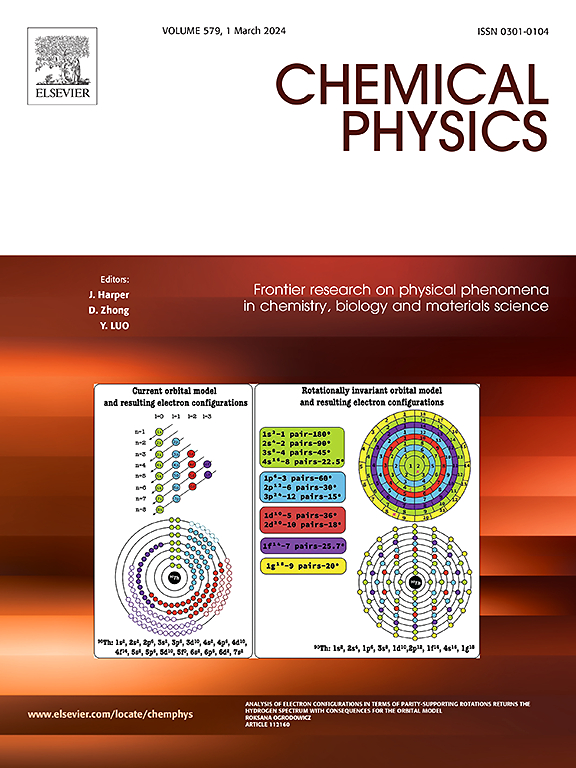去质子化芙蓉素对活性氧和活性氮自由基清除活性的热力学研究
IF 2
3区 化学
Q4 CHEMISTRY, PHYSICAL
引用次数: 0
摘要
去质子化的类黄酮被认为是比中性形式更有效的抗氧化剂。本研究考察了羟基化程度最高的黄酮醇hibiscetin单去质子形式的氢原子转移(HAT)和顺序质子损失电子转移(SPLET)机制的反应焓。由于去质子化在水介质中非常普遍,因此选择它作为研究介质。去质子化的hibiscetin倾向于进入SPLET反应途径进行HAT或电子转移。因此,顺序双质子损失电子转移(SdPLET)途径为芙蓉素在水相中的抗氧化活性提供了更强的理由。顺序质子损失氢原子转移(SPLHAT)过程也可以在水介质中竞争性地发生。通过计算电子转移平衡常数和氧化还原电位,评估了木犀草素和单去质子化木犀草素清除水溶液中已知破坏生物系统的五种活性氧和活性氮(ROS和RNS)的可行性。羟基自由基在活性氧和活性氧中对氢原子和电子的吸引力最强。它的平衡常数也表明芙蓉素和去质子芙蓉素对它的清除是非常有利的和自发的。在单去质子化的情况下,较高的平衡常数值证实了它具有更好的清除活性物质的能力。本文章由计算机程序翻译,如有差异,请以英文原文为准。

Thermodynamics of free radical scavenging activity of deprotonated hibiscetin towards reactive oxygen and nitrogen species
Deprotonated flavonoids are known to be more potent antioxidants than neutral forms. This study examined the reaction enthalpies for the mono-deprotonated forms of the most hydroxylated flavonol, hibiscetin, concerning hydrogen atom transfer (HAT) and sequential proton-loss electron-transfer (SPLET) mechanisms. Since deprotonation is highly prevalent in the aqueous medium, it was chosen as the medium of investigation. Deprotonated hibiscetin prefers to enter the SPLET reaction pathway to HAT or electron transfer. Hence, the sequential double proton loss electron transfer (SdPLET) route offers a stronger justification for the antioxidant activity of hibiscetin in the aqueous phase. The sequential proton loss hydrogen atom transfer (SPLHAT) process can also take place in the aqueous media competitively. The viability of Hibiscetin and mono-deprotonated Hibiscetin in scavenging five reactive oxygen and nitrogen species (ROS and RNS) that are known to damage biological systems in the aqueous solution was assessed by calculating the equilibrium constant and redox potential of electron transfer. The hydroxyl radical exhibited the strongest attraction for the hydrogen atom and electron among the ROS and RNS under consideration. Its equilibrium constants also indicated that hibiscetin and deprotonated hibiscetin scavenge it in a highly advantageous and spontaneous manner. The higher values of the equilibrium constant in the case of mono-deprotonated hibiscetin confirmed its better capacity for scavenging reactive species.
求助全文
通过发布文献求助,成功后即可免费获取论文全文。
去求助
来源期刊

Chemical Physics
化学-物理:原子、分子和化学物理
CiteScore
4.60
自引率
4.30%
发文量
278
审稿时长
39 days
期刊介绍:
Chemical Physics publishes experimental and theoretical papers on all aspects of chemical physics. In this journal, experiments are related to theory, and in turn theoretical papers are related to present or future experiments. Subjects covered include: spectroscopy and molecular structure, interacting systems, relaxation phenomena, biological systems, materials, fundamental problems in molecular reactivity, molecular quantum theory and statistical mechanics. Computational chemistry studies of routine character are not appropriate for this journal.
 求助内容:
求助内容: 应助结果提醒方式:
应助结果提醒方式:


